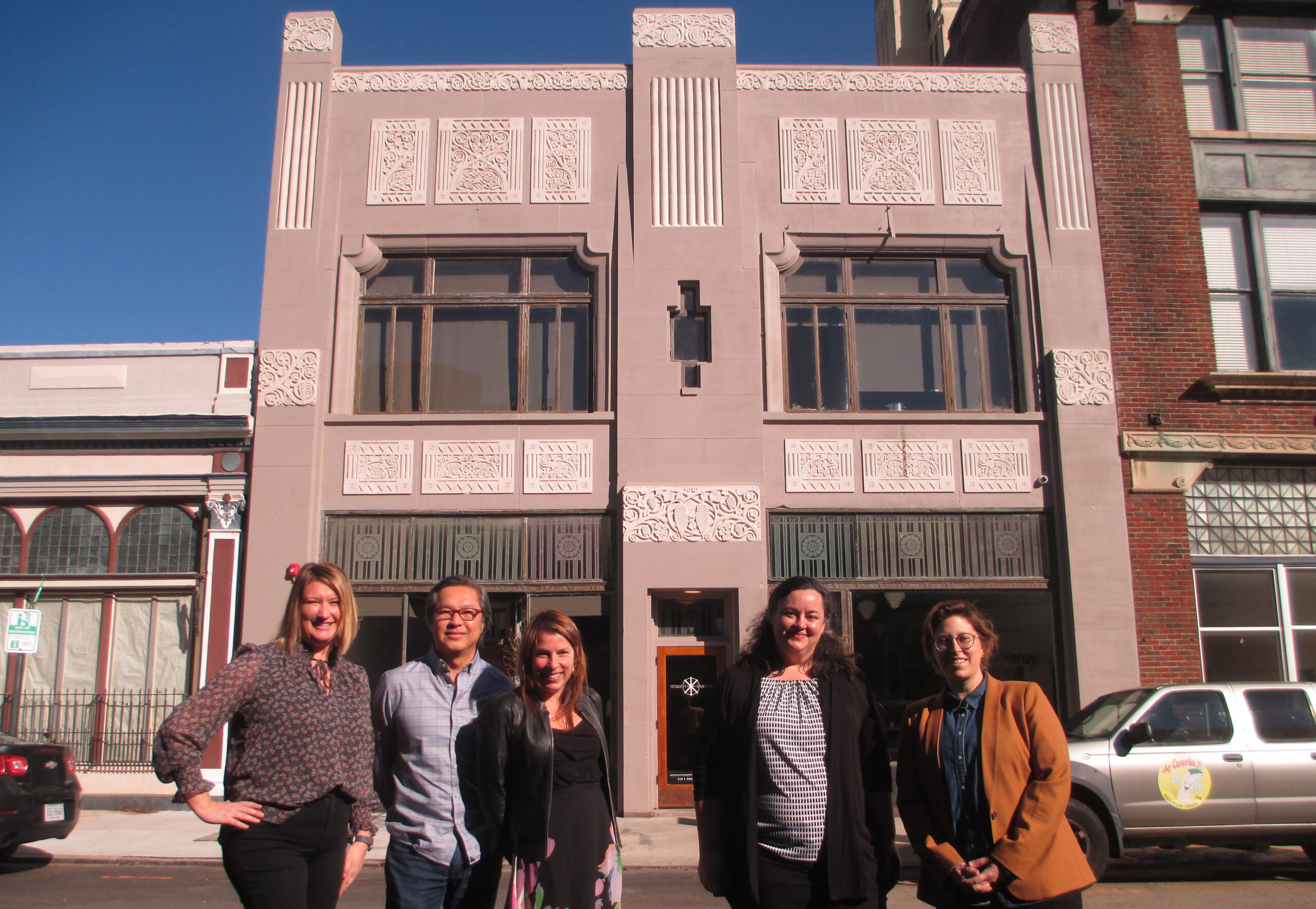
Outside their respective storefronts at 208-212 E. Grace St. are, from left, Markham Planning’s Emily Parnell, Tom Phan and Lory Markham, and Sadler & Whitehead’s Catherine Easterling and Kathleen Morgan. (Jonathan Spiers photos)
When Lory Markham was showing the Art Deco-style building at 208-212 E. Grace St. to one of her real estate clients a couple years ago, the associate broker with One South Commercial said she knew she had found the space that she herself had been trying to find for her own business: development consulting firm Markham Planning.
“I actually showed this building to somebody else and went back to the office and said, ‘Tom, we need to buy this building,’” Markham said, referring to One South Commercial head Tom Rosman, who along with his wife Michelle went in with Markham to buy and rehab the nearly century-old building into two office storefronts and 10 apartments.
“We love the building, we thought it made good financial sense and, being in real estate, I wanted to own the office that I was in,” said Markham, who previously rented a space a couple blocks away.
The $2 million project wrapped up last fall, with a quick lease-up on the apartments and the storefronts now home to Markham’s firm and to fellow consultancy Sadler & Whitehead, a historic preservation and adaptive reuse firm that also worked with Markham and the Rosmans on the project.
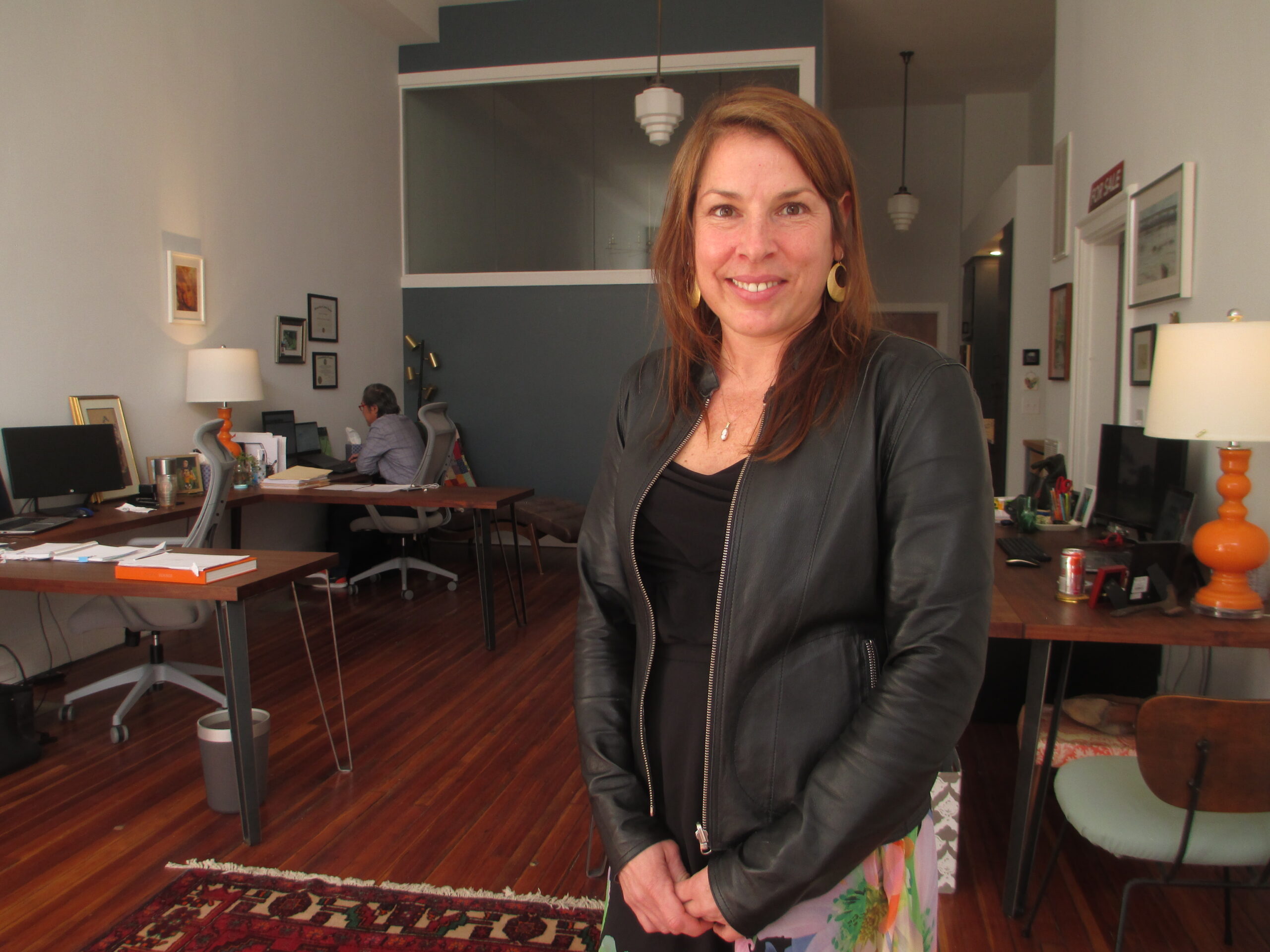
Lory Markham, in her consulting business’s new office, bought the building with One South Commercial colleagues Tom and Michelle Rosman.
“We hired them to help us with the historic tax credits. As they were touring the building, we were looking for a tenant and they were looking for a new home,” Markham said. “The timing just worked out really well for us and for them.”
The move marks a new chapter for Sadler & Whitehead, which is under new ownership following the retirement of co-founder Mimi Sadler in 2020.
Leading the 25-year-old firm now are longtime employees Catherine Easterling and Kathleen Morgan, who Sadler sold the business to and who share ownership 50-50.
Occasional collaborators with Markham Planning on projects, the duo also has personal and professional connections with Markham — and with the building. Easterling’s grandparents met there, and she and Markham both worked in the planning and development review department at City Hall, rubbing shoulders there over a six-year stretch.
“We had similar roles, different prerogatives,” Markham said.
Laughing, Easterling added: “She was asking people to put windows in buildings, and I was saying, ‘No, you cannot do that.’”
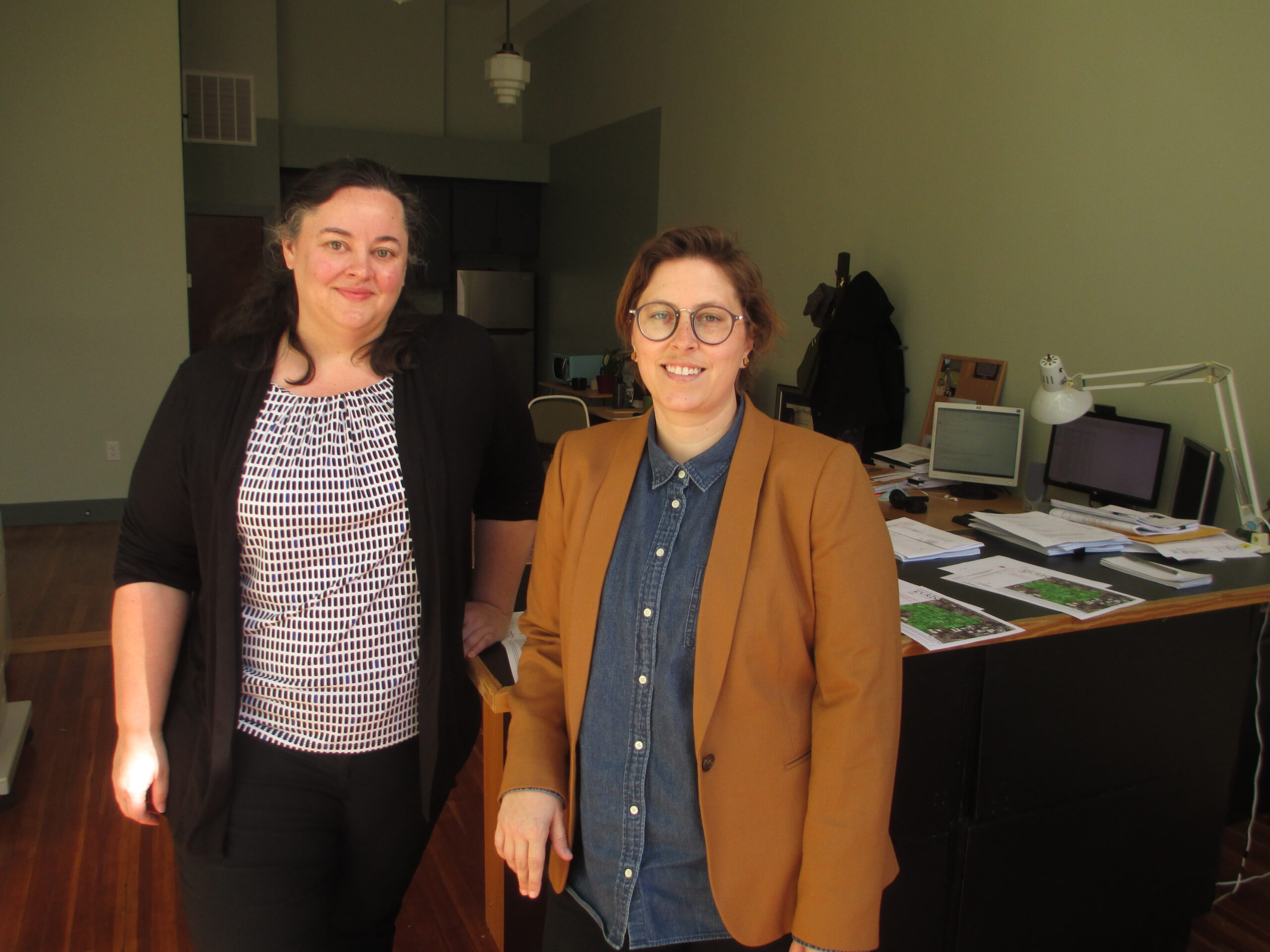
Catherine Easterling, left, and Kathleen Morgan now co-own Sadler & Whitehead, where they’ve worked since 2013 and 2017, respectively.
When Easterling toured the building, she said she immediately realized she had a family connection to it from when it was once a Baptist bookstore.
“I said, ‘Oh, my grandparents met here, in this exact space,’” she recalled telling Markham. “My granddad got his hand caught in the door, and the manager of the bookstore called my grandmom. She bandaged his hand, and that’s how they met. I didn’t want to strongarm Kathleen into anything, but I felt very connected to the building.”
Fortunately for Easterling, Morgan was already on board. The two had previously been working out of Sadler’s home office.
“We had been looking and we had not found anything that we liked. It was perfect timing,” Morgan said. “This was exactly what we were looking for: something central, a storefront space.”
History uncovered
Built in 1930, the two-story building is listed on the National Register of Historic Places as one of several that make up the Grace Street Commercial Historic District. Referred to on the register as the O.P. Brisner Store building, it was designed by Richmond architect Henry Carl Messerschmidt, who also designed the nearby building that now houses Perly’s restaurant.
Most recently home to a Modern Coin shop – “We still get people who bring sacks of coins,” Markham said – and a local artist who she said resided upstairs, the building was in rough shape when she and the Rosmans bought it in October 2020, paying $548,000. The building had previously been under contract to another buyer, but that deal, which wasn’t brokered by Markham, didn’t go through.
The seller was a trust under the name of previous owner Sharon Ciner. City property records show the 8,600-square-foot building with a 3,900-square-foot basement was assessed in 2020 at $391,000. The now-improved property is assessed at $1.92 million.
The rehab, headed up by Monument Construction, revealed features that had been covered up by dropped ceilings and other alterations, such as etched glass transoms above the now-restored storefront windows, and an octagonal skylight that illuminates the similar-shaped foyer for the upstairs apartments.
“It’s just a really unique little building,” Markham said. “It has lots of character, and we were really drawn to it. It has lots of natural light, and the octagon, which is such a unique architectural characteristic. This little stretch of Grace Street has a lot of Art Deco buildings. I think this one might be the most ornate.”
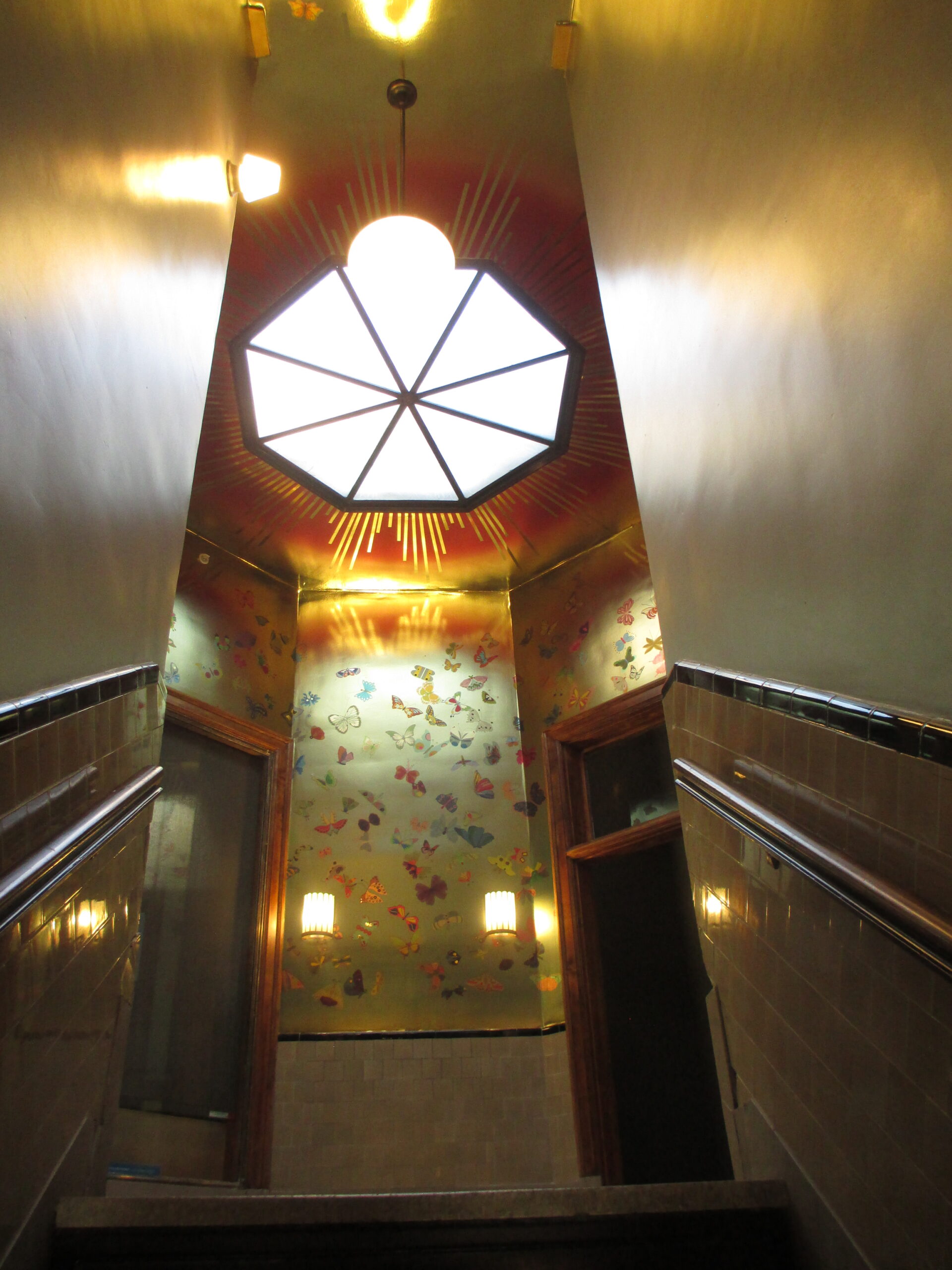
The upstairs foyer features an octagonal skylight and decorative wallpaper by local designer Sarah Rowland.
Walter Parks Architects designed the rehab, which fitted seven one-bedroom apartments and three two-bedrooms across the upstairs level, the basement and the back of the first floor. The apartments have access to a courtyard and parking behind the building, and rent from about $1,100 to $1,700 a month.
Markham said the units leased up quickly. She and the Rosmans are currently handling leasing and property management.
Taste for development
The project also gave Markham her first crack at real estate development after five years working on the consulting side. She said the experience will benefit both of her professional pursuits.
“I learned a lot that I think is super-beneficial to both my planning business and the real estate side of things, because now I’ve done it and I have a whole different perspective and understanding of what it takes,” she said. “Observing something and doing something, you get a different perspective.”
While she said she’s not looking to become a developer, Markham’s Grace Street project won’t be her last. She and Parks recently bought a building behind it — 211 E. Broad St., previously home to Colonial Hairgoods Co. — which they’re converting into nine apartments and a commercial space.
Markham and Parks paid $569,000 for that building in late December. It was assessed at the time at $513,000.
Markham said that project presented itself while they were working on the Grace Street building around the block.
“It’s in really bad shape. Like, holes-in-the-floor-all-the-way-to-the-basement bad shape,” she said of the Broad Street building. “Now being a property owner on the block, I want to fix it up. But I also became friends with (the seller) and she needed to retire. Walter owns the building next door with UrbanCore (Construction) and there’s a shared stair. Surprisingly, he said OK.”
She added, “It was not a goal of mine to get into development or be a developer, but having done this building was really fun and that opportunity just sort of presented itself.”
New neighbors
Previously based in a building a couple blocks away, Markham Planning now occupies the 208 E. Grace St. storefront, while Sadler & Whitehead have the 212 space. The 210 door between them leads to the apartments.
While Easterling and Morgan have their space to themselves, Markham shares hers with two employees: Tom Phan, a fellow city planning alum; and Emily Parnell, a longtime friend of Markham’s.
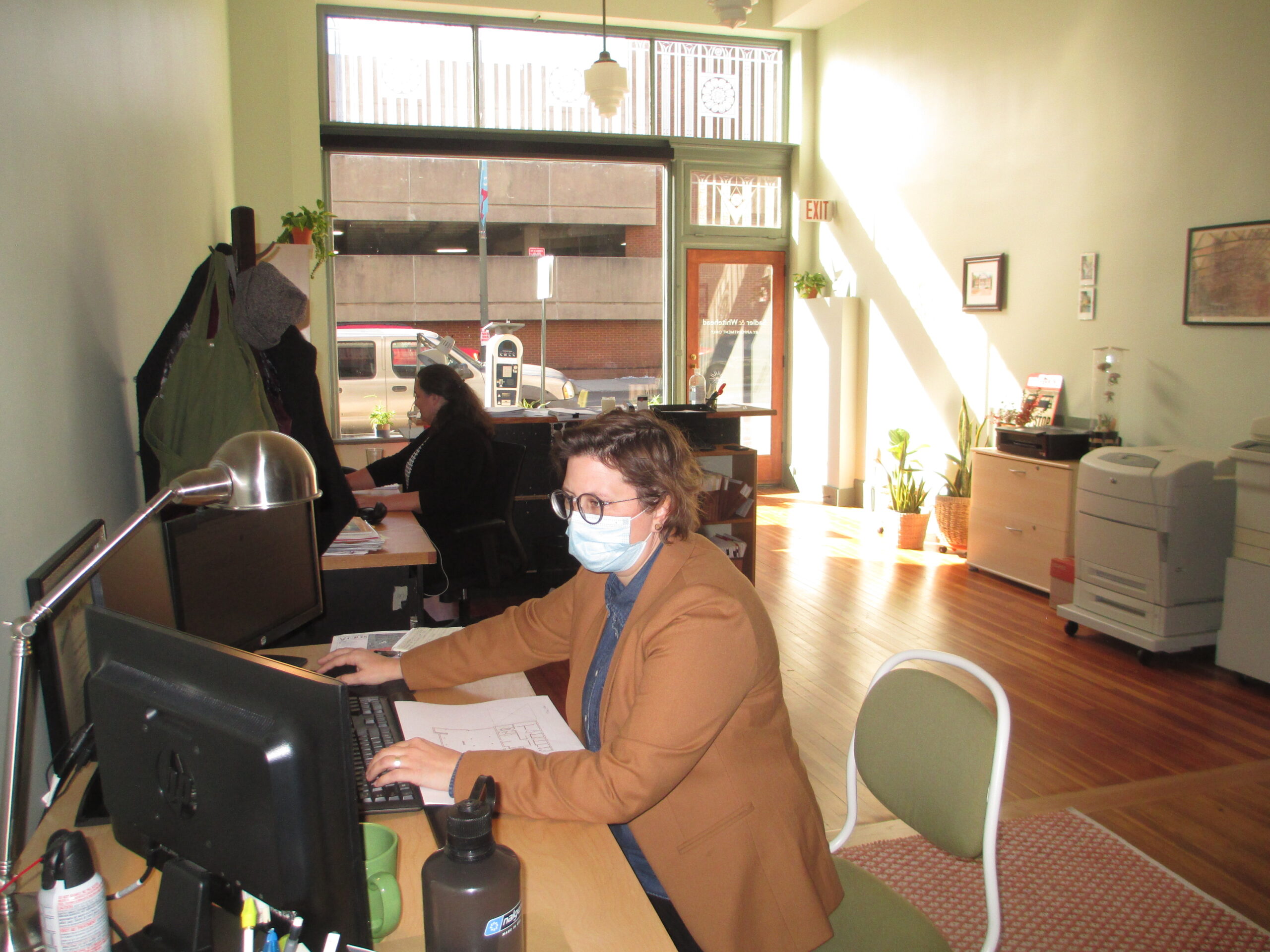
Kathleen Morgan and Catherine Easterling at work in their space. They previously worked out of firm co-founder Mimi Sadler’s home office.
Five years into the business, Markham said they’re keeping busy guiding clients through the inner workings of City Hall, where Markham developed an insider’s perspective after a decade as a city planner.
“It’s a lot different than what I thought I would be doing five years ago,” Markham said of her business. “Some of that is due to the market and demand, and what people need and having to adjust to that. Some of it is just COVID, and how the city accepts applications. The way that they are processing stuff is just a lot different than it used to be. But it still seems like people need help with that.”
She added, laughing, “It’s not that they necessarily need help; it’s that they don’t want the pain and suffering of going through it. I enjoy it. It makes me feel like I’m helping projects and helping people. And, I like the people down at City Hall. If you haven’t been down there, I think it’s more painful, because you don’t understand where they’re coming from. I’ve been there and been through it.”
As for Easterling and Morgan, they said they’re keeping up the pace that Sadler and co-founder Camden Whitehead established as one of Richmond’s earliest historic tax credit consultancies.
“She was one of the first, if not the first, to do tax credit consulting,” Morgan said, noting the name recognition built over a quarter-century in business. “That’s why we kept the name.”
Added Easterling: “We talked about changing the name, and Mimi said if we wanted to keep it, we could keep it. We thought, this is a no-brainer. There’s so much name recognition. Mimi garners so much respect in the tax credit community.”

Outside their respective storefronts at 208-212 E. Grace St. are, from left, Markham Planning’s Emily Parnell, Tom Phan and Lory Markham, and Sadler & Whitehead’s Catherine Easterling and Kathleen Morgan. (Jonathan Spiers photos)
When Lory Markham was showing the Art Deco-style building at 208-212 E. Grace St. to one of her real estate clients a couple years ago, the associate broker with One South Commercial said she knew she had found the space that she herself had been trying to find for her own business: development consulting firm Markham Planning.
“I actually showed this building to somebody else and went back to the office and said, ‘Tom, we need to buy this building,’” Markham said, referring to One South Commercial head Tom Rosman, who along with his wife Michelle went in with Markham to buy and rehab the nearly century-old building into two office storefronts and 10 apartments.
“We love the building, we thought it made good financial sense and, being in real estate, I wanted to own the office that I was in,” said Markham, who previously rented a space a couple blocks away.
The $2 million project wrapped up last fall, with a quick lease-up on the apartments and the storefronts now home to Markham’s firm and to fellow consultancy Sadler & Whitehead, a historic preservation and adaptive reuse firm that also worked with Markham and the Rosmans on the project.

Lory Markham, in her consulting business’s new office, bought the building with One South Commercial colleagues Tom and Michelle Rosman.
“We hired them to help us with the historic tax credits. As they were touring the building, we were looking for a tenant and they were looking for a new home,” Markham said. “The timing just worked out really well for us and for them.”
The move marks a new chapter for Sadler & Whitehead, which is under new ownership following the retirement of co-founder Mimi Sadler in 2020.
Leading the 25-year-old firm now are longtime employees Catherine Easterling and Kathleen Morgan, who Sadler sold the business to and who share ownership 50-50.
Occasional collaborators with Markham Planning on projects, the duo also has personal and professional connections with Markham — and with the building. Easterling’s grandparents met there, and she and Markham both worked in the planning and development review department at City Hall, rubbing shoulders there over a six-year stretch.
“We had similar roles, different prerogatives,” Markham said.
Laughing, Easterling added: “She was asking people to put windows in buildings, and I was saying, ‘No, you cannot do that.’”

Catherine Easterling, left, and Kathleen Morgan now co-own Sadler & Whitehead, where they’ve worked since 2013 and 2017, respectively.
When Easterling toured the building, she said she immediately realized she had a family connection to it from when it was once a Baptist bookstore.
“I said, ‘Oh, my grandparents met here, in this exact space,’” she recalled telling Markham. “My granddad got his hand caught in the door, and the manager of the bookstore called my grandmom. She bandaged his hand, and that’s how they met. I didn’t want to strongarm Kathleen into anything, but I felt very connected to the building.”
Fortunately for Easterling, Morgan was already on board. The two had previously been working out of Sadler’s home office.
“We had been looking and we had not found anything that we liked. It was perfect timing,” Morgan said. “This was exactly what we were looking for: something central, a storefront space.”
History uncovered
Built in 1930, the two-story building is listed on the National Register of Historic Places as one of several that make up the Grace Street Commercial Historic District. Referred to on the register as the O.P. Brisner Store building, it was designed by Richmond architect Henry Carl Messerschmidt, who also designed the nearby building that now houses Perly’s restaurant.
Most recently home to a Modern Coin shop – “We still get people who bring sacks of coins,” Markham said – and a local artist who she said resided upstairs, the building was in rough shape when she and the Rosmans bought it in October 2020, paying $548,000. The building had previously been under contract to another buyer, but that deal, which wasn’t brokered by Markham, didn’t go through.
The seller was a trust under the name of previous owner Sharon Ciner. City property records show the 8,600-square-foot building with a 3,900-square-foot basement was assessed in 2020 at $391,000. The now-improved property is assessed at $1.92 million.
The rehab, headed up by Monument Construction, revealed features that had been covered up by dropped ceilings and other alterations, such as etched glass transoms above the now-restored storefront windows, and an octagonal skylight that illuminates the similar-shaped foyer for the upstairs apartments.
“It’s just a really unique little building,” Markham said. “It has lots of character, and we were really drawn to it. It has lots of natural light, and the octagon, which is such a unique architectural characteristic. This little stretch of Grace Street has a lot of Art Deco buildings. I think this one might be the most ornate.”

The upstairs foyer features an octagonal skylight and decorative wallpaper by local designer Sarah Rowland.
Walter Parks Architects designed the rehab, which fitted seven one-bedroom apartments and three two-bedrooms across the upstairs level, the basement and the back of the first floor. The apartments have access to a courtyard and parking behind the building, and rent from about $1,100 to $1,700 a month.
Markham said the units leased up quickly. She and the Rosmans are currently handling leasing and property management.
Taste for development
The project also gave Markham her first crack at real estate development after five years working on the consulting side. She said the experience will benefit both of her professional pursuits.
“I learned a lot that I think is super-beneficial to both my planning business and the real estate side of things, because now I’ve done it and I have a whole different perspective and understanding of what it takes,” she said. “Observing something and doing something, you get a different perspective.”
While she said she’s not looking to become a developer, Markham’s Grace Street project won’t be her last. She and Parks recently bought a building behind it — 211 E. Broad St., previously home to Colonial Hairgoods Co. — which they’re converting into nine apartments and a commercial space.
Markham and Parks paid $569,000 for that building in late December. It was assessed at the time at $513,000.
Markham said that project presented itself while they were working on the Grace Street building around the block.
“It’s in really bad shape. Like, holes-in-the-floor-all-the-way-to-the-basement bad shape,” she said of the Broad Street building. “Now being a property owner on the block, I want to fix it up. But I also became friends with (the seller) and she needed to retire. Walter owns the building next door with UrbanCore (Construction) and there’s a shared stair. Surprisingly, he said OK.”
She added, “It was not a goal of mine to get into development or be a developer, but having done this building was really fun and that opportunity just sort of presented itself.”
New neighbors
Previously based in a building a couple blocks away, Markham Planning now occupies the 208 E. Grace St. storefront, while Sadler & Whitehead have the 212 space. The 210 door between them leads to the apartments.
While Easterling and Morgan have their space to themselves, Markham shares hers with two employees: Tom Phan, a fellow city planning alum; and Emily Parnell, a longtime friend of Markham’s.

Kathleen Morgan and Catherine Easterling at work in their space. They previously worked out of firm co-founder Mimi Sadler’s home office.
Five years into the business, Markham said they’re keeping busy guiding clients through the inner workings of City Hall, where Markham developed an insider’s perspective after a decade as a city planner.
“It’s a lot different than what I thought I would be doing five years ago,” Markham said of her business. “Some of that is due to the market and demand, and what people need and having to adjust to that. Some of it is just COVID, and how the city accepts applications. The way that they are processing stuff is just a lot different than it used to be. But it still seems like people need help with that.”
She added, laughing, “It’s not that they necessarily need help; it’s that they don’t want the pain and suffering of going through it. I enjoy it. It makes me feel like I’m helping projects and helping people. And, I like the people down at City Hall. If you haven’t been down there, I think it’s more painful, because you don’t understand where they’re coming from. I’ve been there and been through it.”
As for Easterling and Morgan, they said they’re keeping up the pace that Sadler and co-founder Camden Whitehead established as one of Richmond’s earliest historic tax credit consultancies.
“She was one of the first, if not the first, to do tax credit consulting,” Morgan said, noting the name recognition built over a quarter-century in business. “That’s why we kept the name.”
Added Easterling: “We talked about changing the name, and Mimi said if we wanted to keep it, we could keep it. We thought, this is a no-brainer. There’s so much name recognition. Mimi garners so much respect in the tax credit community.”

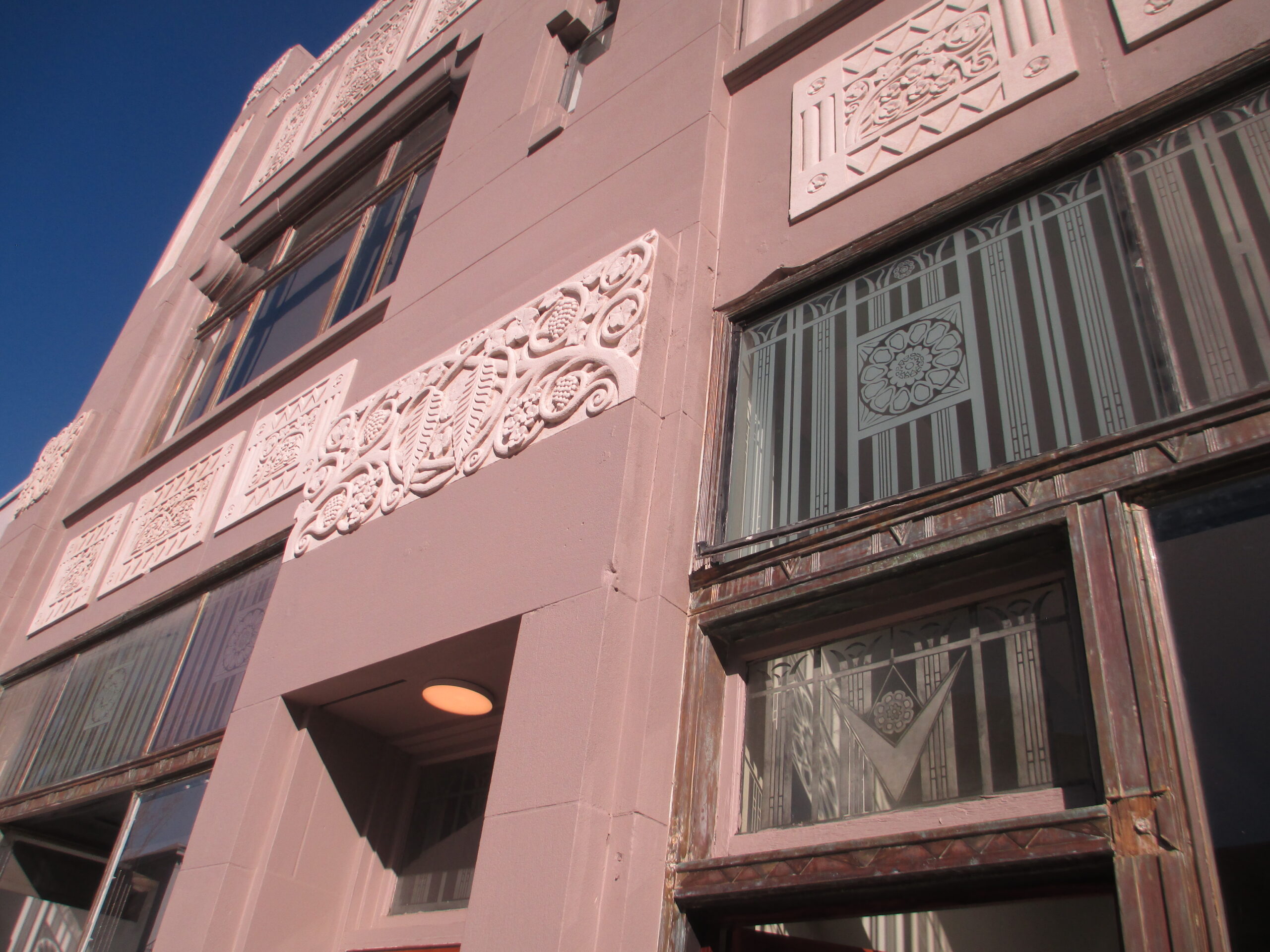



Two great companies! Congrats and welcome to the neighborhood!
Great news to see that building saved and used efficiently.
fun project and wonderful people
Great building! I have always loved this one. And great story. Congrats to all!
Lowry’s is a great story for the development community. She was very well known by developers when she chose to come over to “the dark side”. She’s been able to balance her consulting business with her very capable brokerage skills, and she’s a breath of fresh air with whom to work. Congrats on the new offices, Lory!
What a great combination of tenants and a wonderful project. Congratulations, all!
Great news Lory. Congratulations!